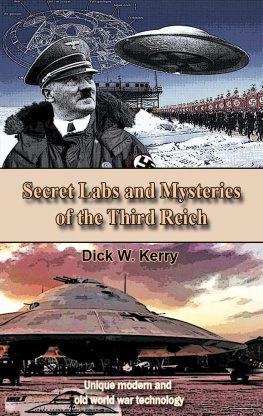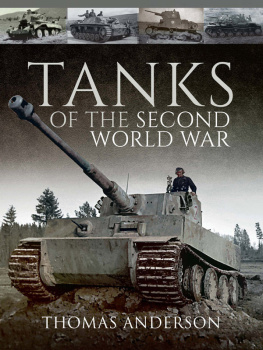William S. Carson - Light Tanks of Germany in the World War II (Extended edition): Unique modern and old world war technology
Here you can read online William S. Carson - Light Tanks of Germany in the World War II (Extended edition): Unique modern and old world war technology full text of the book (entire story) in english for free. Download pdf and epub, get meaning, cover and reviews about this ebook. year: 2020, genre: History. Description of the work, (preface) as well as reviews are available. Best literature library LitArk.com created for fans of good reading and offers a wide selection of genres:
Romance novel
Science fiction
Adventure
Detective
Science
History
Home and family
Prose
Art
Politics
Computer
Non-fiction
Religion
Business
Children
Humor
Choose a favorite category and find really read worthwhile books. Enjoy immersion in the world of imagination, feel the emotions of the characters or learn something new for yourself, make an fascinating discovery.

- Book:Light Tanks of Germany in the World War II (Extended edition): Unique modern and old world war technology
- Author:
- Genre:
- Year:2020
- Rating:5 / 5
- Favourites:Add to favourites
- Your mark:
- 100
- 1
- 2
- 3
- 4
- 5
Light Tanks of Germany in the World War II (Extended edition): Unique modern and old world war technology: summary, description and annotation
We offer to read an annotation, description, summary or preface (depends on what the author of the book "Light Tanks of Germany in the World War II (Extended edition): Unique modern and old world war technology" wrote himself). If you haven't found the necessary information about the book — write in the comments, we will try to find it.
William S. Carson: author's other books
Who wrote Light Tanks of Germany in the World War II (Extended edition): Unique modern and old world war technology? Find out the surname, the name of the author of the book and a list of all author's works by series.
Light Tanks of Germany in the World War II (Extended edition): Unique modern and old world war technology — read online for free the complete book (whole text) full work
Below is the text of the book, divided by pages. System saving the place of the last page read, allows you to conveniently read the book "Light Tanks of Germany in the World War II (Extended edition): Unique modern and old world war technology" online for free, without having to search again every time where you left off. Put a bookmark, and you can go to the page where you finished reading at any time.
Font size:
Interval:
Bookmark:
Light Tanks of Germany in the World War II
(Extended edition)
Unique modern and old world war technology
William S. Carson
All rights reserved
William S. Carson, 2017
Fotos by:
Gina Smith
Tanya Dolski
Sam Sanderson
Bill Carson
This is an extended edition. In it I added a description and the history of several little-known light tanks of Germany.
This book is dedicated to the light tanks of Germany during the Second World War. Also here you can learn about the formation of the German tank forces. This edition is corrected and supplemented with historical information.
Content:
Light tank Pz.Kpfw.I
Light tank Pz.Kpfw.II
Pz.Kpfw. II Ausf. L 'Luchs'
PZ.35 (T)
PZ.38 (T)
E-5 Multipurpose armored car
E-10 Tank Destroyer
E-25 (Adler) Tank Destroyer
E-25 (Porsche) Tank Destroyer
Gerat 338 Self-propelled anti-aircraft mount
Kugelpanzer" Observation armored car
Light tank Leichte Kampfwagen Krupp
Intro

In 1939 - 1945 the tanks played a decisive role on the battlefields of the Second World War. Tank connections were the main striking force of the armies of countries that took part in the war and were actively used on all fronts of the fighting.
It was the tank troops in the Second World War that began to play a major role in the battlefields. Along with aviation and artillery tanks were one of the decisive factors to achieve victory in the rapid offensive operations that were conducted throughout the war by the troops of Germany, the USSR, the United States and Britain. A decisive breakthrough in a certain sector of the front with the subsequent resolution of major strategic tasks without the use of tanks was simply impossible.
In the Second World War, tank troops were mobile units of the army. But only by acting large forces the tanks could achieve impressive results. The first to realize this was the German generals. Talented German commanders such as General Guderian and Manstein, using large tank groups, solved complex tasks with limited forces, having managed to defeat the Polish army in two weeks, and then to defeat France in a little more than a month and press the Anglo-French forces against Dunkirk, opponents crushing defeat. Tank troops were a means of making quick strikes on the selected sector of the front, and not letting the enemy come to their senses, conducting bold operations on the encirclement of its forces. The massive blows of the tank forces became the hallmark of all the serious offensive operations of the period of 1939 - 1945.
Production of tanks in 1939 - 1945 years
With the outbreak of World War II, the opposing countries mobilized all the power of their industry to create a huge number of military vehicles. Mass production of tanks during the war years was one of the conditions for achieving an early victory over the enemy. The most impressive tank fleet was the Soviet Union at the beginning of the war. The grandiose production of military equipment, developed in the 1930s, resulted in over 22 thousand rubles. tanks of various types and designs by June 1941. This made it possible, on the eve of the war, to create impressive tank armies, organized into corps. The tank troops of the USSR at the beginning of the Second World War were undoubtedly the most numerous on the planet.
True, most of the Soviet tanks belonged to the class of light, but almost all of this technology was comparable to and even superior to German. Germany was able to produce by that time the Cromwell tank only 5,639 tanks and not all of them took part in the Eastern campaign against the USSR. Thus, the industry of the USSR, having adjusted the mass production of tanks, provided the Red Army with an advantage in combat vehicles of more than four times at the initial stage of the war! This unfortunately did not save the Soviet troops from the defeat during the lightning operations of the Wehrmacht in early 1941.
From huge superiority in technology, for a variety of reasons, there was not a trace left. Britain at that time also rapidly increased the production of military equipment, because at the beginning of the war its tank forces were extremely small - only about 600 combat vehicles. And during the entire war the production of tanks in the UK was not as significant as in the USSR, Germany or the Mathilde US tank. The latter initially produced only light tanks in small volumes, but quickly realizing the importance of tanks in modern warfare, the Americans quickly began to produce in larger quantities more advanced combat vehicles and the creation of modern, battle-worthy tank forces.
In general, the allies managed to seriously exceed the industry of their opponents. In addition to Germany in the Axis bloc, no one could boast of a serious industrial potential. The main Pacific ally of Germany - Japan, was in this respect incomparable with the countries of the anti-Hitler coalition. Despite the impressive growth of military production, Germany was hopelessly inferior in the production of military equipment to its opponents. Do not forget that against it were two industrial giants - the USSR and the United States, whose total industrial potential was simply incommensurable. Only one eastern enemy of Germany-the USSR produced over one hundred thousand units of armored vehicles, the United States alone, the Sherman tanks, produced more than 48,000 units, and Britain produced more than 25,000 during the war years tanks.
Even without taking into account other equipment (auxiliary cars, trucks, armored personnel carriers, automatic control systems, etc.) besides the tanks themselves, it becomes clear how far Germany was inferior to its opponents. German industry was able to give for the same period only 89 thousand armored cars. The strong lag behind the USSR in the production of tanks was one of the reasons for the defeat of Hitler's Germany in World War II. The tank forces of the USSR at the final stage of the war simply shook the German defensive front with swift and powerful breakthroughs, to which the Wehrmacht could no longer oppose anything. Over the course of the war, more than 200,000 tanks of various types were launched by the opposing sides.
The tanks of Germany before the Second World War

The Second World War is called the "War of Motors" - this is true, because it involved a huge number of tanks, aircraft, cars and other equipment. If Germany respected the terms of the Versailles Peace Treaty of 1919, it would not have a single combat vehicle. Hitler ventured to bypass this condition.
The British, the authors of the tank, (in fact, the tank of the Assyrian invention) saw great potential in this machine, so they forbade the Germans to create their own samples of this type of equipment. But even before the Nazi party came to power, in the late twenties famous German firms Krupp, Rheinmetal and Daimler-Benz secretly established at their enterprises several light and medium tanks.
Under Hitler, the process of developing tanks was accelerated many times and was carried out almost openly. Neither England nor France reacted in any way to the rapid modernization of the army of the Germans. And at that time not only technology was modernized, but a new approach to conflict management was born. Special place according to the new strategy was assigned to tank units. In this regard, the government of the "Third Reich" instructed several firms to develop a light tank project. The best was the Krupp machine. Since July 1934, it has been produced serially under the brand Pz. Kpfw. I Ausf. A (Panzer Kampfwagen I Ausf A. Panzer - a tank, Kampawagen - literally a military van, followed by the model number and its version, this tank was version A). For two years the German industry produced 818 tanks of this version.
Next pageFont size:
Interval:
Bookmark:
Similar books «Light Tanks of Germany in the World War II (Extended edition): Unique modern and old world war technology»
Look at similar books to Light Tanks of Germany in the World War II (Extended edition): Unique modern and old world war technology. We have selected literature similar in name and meaning in the hope of providing readers with more options to find new, interesting, not yet read works.
Discussion, reviews of the book Light Tanks of Germany in the World War II (Extended edition): Unique modern and old world war technology and just readers' own opinions. Leave your comments, write what you think about the work, its meaning or the main characters. Specify what exactly you liked and what you didn't like, and why you think so.

![William Henry Lowe Watson - A Company Of Tanks [Illustrated Edition]](/uploads/posts/book/291202/thumbs/william-henry-lowe-watson-a-company-of-tanks.jpg)




